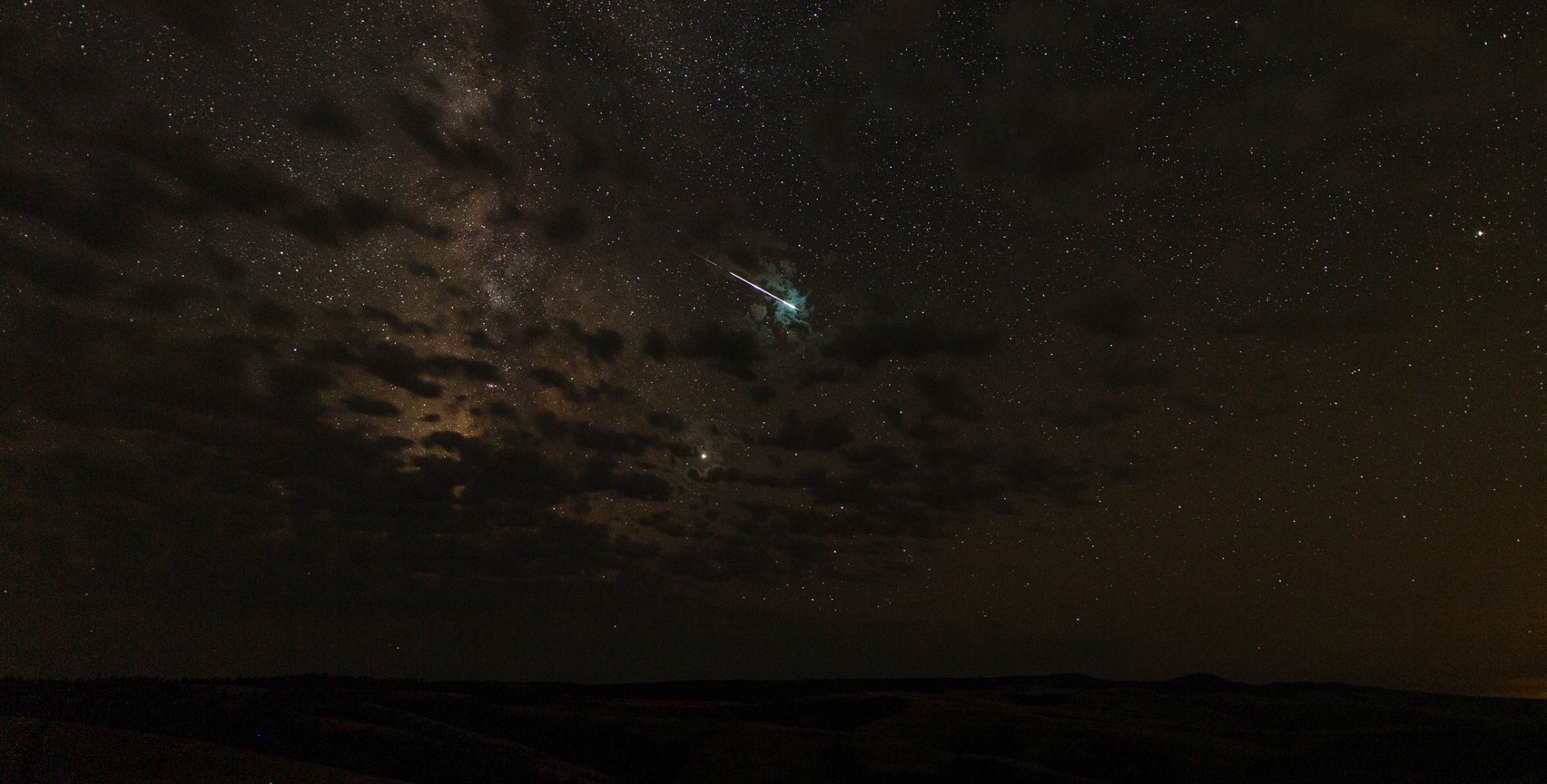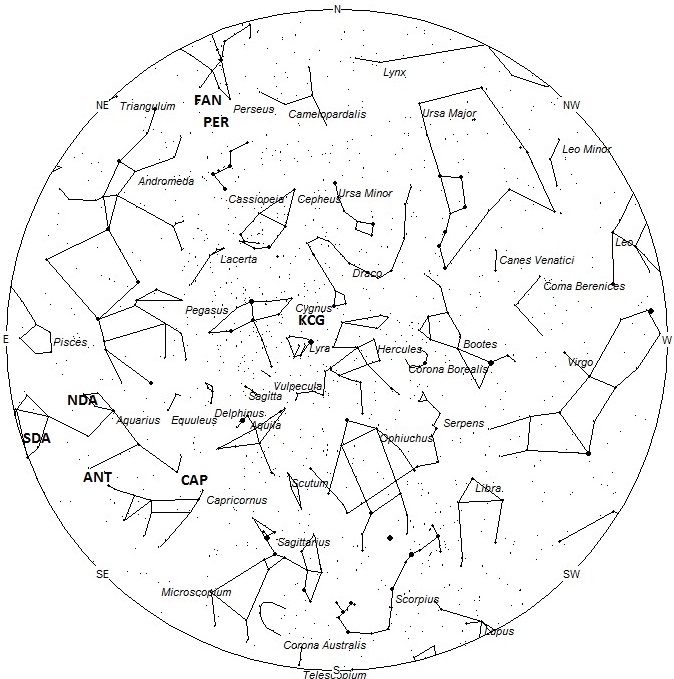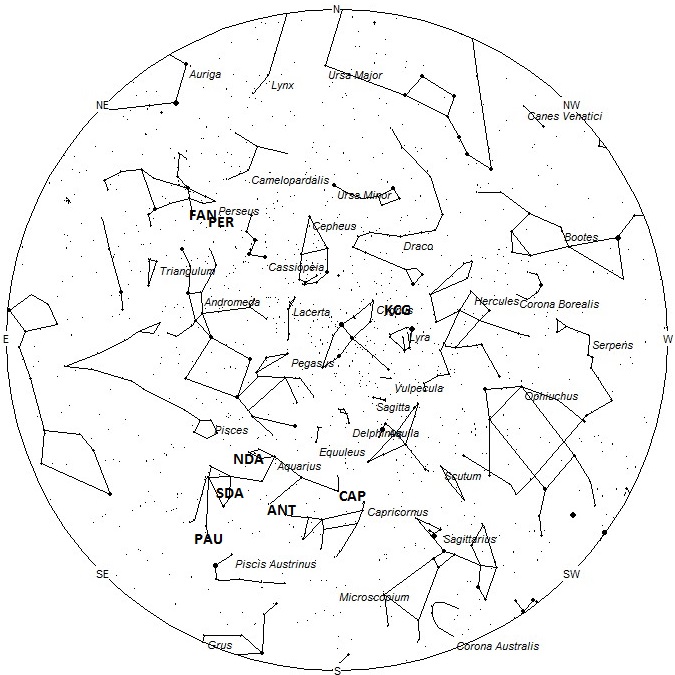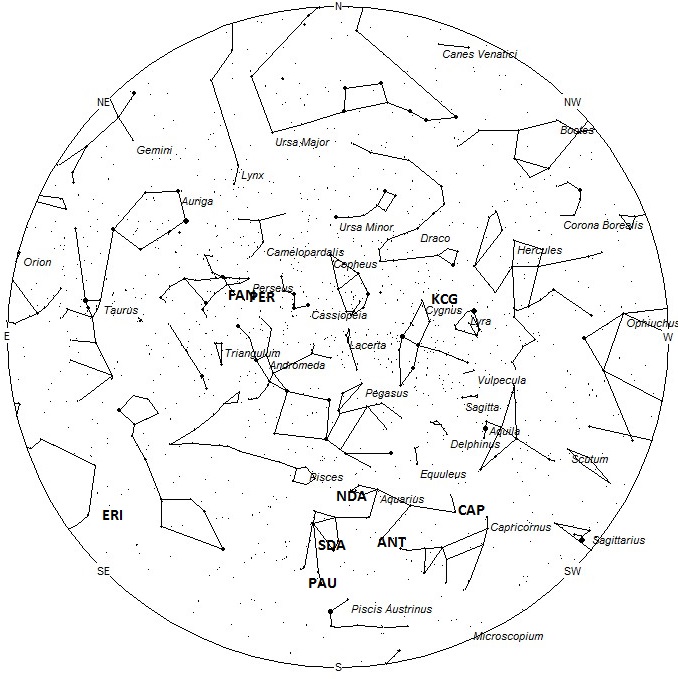
Meteor activity kicks into high gear in August as seen from the northern hemisphere. The main reason for all this activity is the Perseid shower that peaks on August 13th. This shower is active most of the month and remains above the level of the sporadic background for a week centered on August 13th. The sporadic activity is also near maximum as seen from the northern hemisphere and is now more than double the rates from just three months ago. As seen from southern hemisphere, meteor rates are still decent but falling rapidly. The sporadic rates continue their downward slide and the Perseid radiant does not rise high into the sky as seen in the southern hemisphere. So rates for the Perseids are greatly reduced when compared to those seen from the northern hemisphere.
During this period the moon reaches its first quarter phase on Wednesday August 7th. On that date the moon is located 90 degrees east of the sun and will set near midnight local daylight saving time (LDST). This weekend the waxing crescent moon will set during the late evening hours and will not interfere with viewing meteor activity. The estimated total hourly meteor rates for evening observers this week is near 5 as seen from mid-northern latitudes and also 4 for those viewing from subtropical southern latitudes (25S). For morning observers the estimated total hourly rates should be near 24 no matter your location. The actual rates will also depend on factors such as personal light and motion perception, local weather conditions, alertness and experience in watching meteor activity. Note that the hourly rates listed below are estimates as viewed from dark sky sites away from urban light sources. Observers viewing from urban areas will see less activity as only the brighter meteors will be visible from such locations.
The radiant (the area of the sky where meteors appear to shoot from) positions and rates listed below are exact for Saturday night/Sunday morning August 3/4. These positions do not change greatly day to day so the listed coordinates may be used during this entire period. Most star atlases (available at science stores and planetariums) will provide maps with grid lines of the celestial coordinates so that you may find out exactly where these positions are located in the sky. A planisphere or computer planetarium program is also useful in showing the sky at any time of night on any date of the year. Activity from each radiant is best seen when it is positioned highest in the sky, either due north or south along the meridian, depending on your latitude. It must be remembered that meteor activity is rarely seen at the radiant position. Rather they shoot outwards from the radiant so it is best to center your field of view so that the radiant lies at the edge and not the center. Viewing there will allow you to easily trace the path of each meteor back to the radiant (if it is a shower member) or in another direction if it is a sporadic. Meteor activity is not seen from radiants that are located below the horizon. The positions below are listed in a west to east manner in order of right ascension (celestial longitude). The positions listed first are located further west therefore are accessible earlier in the night while those listed further down the list rise later in the night.
These sources of meteoric activity are expected to be active this week.
.
The first of the kappa Cygnids (KCG) should appear next week from a radiant located near 18:40 (280) +45. This area of the sky lies in northern Lyra, 6 degrees northeast of the brilliant zero magnitude star known as Vega (alpha Lyrae). This radiant is best laced near 2300 LDST, when it lies on the meridian and is located highest in the sky. The maximum still two weeks away so rates would be low for this source. With an entry velocity of 21 km/sec., the average meteor from this source would be of slow velocity.
The alpha Capricornids (CAP) are active from July 3 through August 11 with maximum activity occurring during the last week of July. The broad maximum occurs anywhere from July 25 to the 30th with visual rates usually around 3 per hour. The radiant is currently located at 20:38 (309) -08, which places it 2 degrees northwest of the 4th magnitude star known as epsilon Aquarii. This radiant is best placed near 01:00 (LDST), when it lies on the meridian and is located highest in the sky. Hourly rates at this time should be near 1 for observers in the northern hemisphere and 2 as seen south of the equator. With an entry velocity of 22 km/sec., the average alpha Cap meteor would be of slow velocity.
The center of the large Anthelion (ANT) radiant is currently located at 21:36 (324) -14. This position lies in northeastern Capricornus, 3 degrees northeast of the 3rd magnitude star known as Deneb Algedi (delta Capricorni Aa). Due to the large size of this radiant, anthelion activity may also appear from western Aquarius as well as Capricornus. This radiant is best placed near 02:00 (LDST), when it lies on the meridian and is located highest in the sky. Rates at this time should be near 2 per hour as seen from mid-northern latitudes (45 N) and 3 per hour as seen from the southern tropics (S 25). With an entry velocity of 30 km/sec., the average anthelion meteor would be of slow velocity.
The Northern delta Aquariids (NDA) are active from July 23 through August 27. The radiant is currently located at 22:33 (338) -02. This position is located in northern Aquarius, 2 degrees south of the 4th magnitude star known as eta Aquarii. Maximum activity is not expected until August 14, so hourly rates will be less than 1 per hour no matter your location. The radiant is best placed near 03:00 LDST, when it lies highest in the sky. With an entry velocity of 38 km/sec., these meteors would be of medium velocities. This shower seems to be a continuation of the Northern June Aquilids, which had been active since early June.
The Southern Delta Aquariids (SDA) are active from a radiant located at 23:01 (345) -15. This position is located in southwestern Aquarius, 1 degree northeast of the 3rd magnitude star known as Skat (delta Aquarii). Maximum activity was expected on July 30th. Current hourly rates will depend on your latitude. Rates seen from mid-northern latitudes will range from 2-3 per hour, depending on the haziness of your skies. Those viewing from the southern tropics will see the best rates of near 5 per hour. The radiant rises near 22:00 LDST for observers located in the mid-northern latitudes, but is best placed near 04:00 LDST, when it lies highest in the sky. With an entry velocity of 41 km/sec., most activity from this radiant would be of average velocities.
The Piscids Austrinids (PAU) are an obscure shower, not well seen from the northern hemisphere. Recent studies by the IMO Video Network shows little activity. Other studies have indicated that this shower is active later than previously thought. We will go along with that idea until more information is available. It is now thought that this radiant is active from July 31 through August 19, with maximum activity occurring on the 9th. Using these parameters, the current position of the radiant would be 23:10 (349) -22. This area of the sky is located in southwestern Aquarius, near the spot occupied by the faint star known as 88 Aquarii. The radiant is best placed near 04:00 LDST, when it lies highest in the sky. Current rates should be less than 1 for those viewing from mid-northern latitudes and near 1 per hour for observers in the southern hemisphere. With an entry velocity of 44km/sec., most activity from this radiant would be of average velocities.
The Perseids (PER) are active from a radiant located at 02:20 (035) +55. This position lies in northwestern Perseus, 4 degrees southwest of the 4th magnitude star known as Miram (eta Persei). This area of the sky is best placed for viewing during the last dark hour before dawn when it lies highest in the sky. Maximum is not until August 13 so current rates are expected to be near 5 per hour as seen from the northern hemisphere and 2 as seen from south of the equator. Unfortunately these meteors are not well seen from the southern hemisphere. With an entry velocity of 59 km/sec., the average meteor from this source would be of swift velocity.
The eta Eridanids (ERI) were discovered by Japanese observers back in 2001. Activity from this stream is seen from July 23 through September 17 with maximum activity occurring on August 11. The radiant currently lies at 02:32 (038) -14 which places it in eastern Cetus, 4 degrees west of the 4th magnitude star known as pi Ceti. This area of the sky is best seen during the last dark hour before dawn when the radiant lies highest in a dark sky. Current rates are expected to be near 1 per hour during this period no matter your location. With an entry velocity of 65 km/sec., the average meteor from this source would be of swift velocity.
The 49 Andromedids (FAN) were discovered by Željko Andreić and the Croatian Meteor Network team based on studying SonotaCo and CMN observations (SonotaCo 2007-2011, CMN 2007-2010). These meteors are active from July 6 through August 14 with maximum activity occurring on July 21. The current position of the radiant is 02:41 (040) +53. This position lies in northwestern Perseus, 1 degree west of the 4th magnitude star known as tau Persei. Hourly rates are currently expected to be less than 1 no matter your location. With an entry velocity of 60 km/sec., the average meteor from this source would be of swift speed.
The psi Cassiopeiids (PCA) were discovered by Zdenek Sekanina in his study of radio streams. These meteors are active from July 5 through August 7 with maximum activity occurring on July 22. The current position of the radiant is 03:47 (057) +78. This position lies in northeastern Cassiopeia, 8 degrees northeast of the faint star known as 50 Cassiopeiae. Hourly rates are currently expected to be near less than 1 as no matter your location. With an entry velocity of 42 km/sec., the average psi Cassiopeiid meteor would be of medium speed.
As seen from the mid-northern hemisphere (45N) one would expect to see approximately 12 sporadic meteors per hour during the last hour before dawn as seen from rural observing sites. Evening rates would be near 4 per hour. As seen from the tropical southern latitudes (25S), morning rates would be near 9 per hour as seen from rural observing sites and 3 per hour during the evening hours. Locations between these two extremes would see activity between the listed figures.
The list below offers the information from above in tabular form. Rates and positions are exact for Saturday night/Sunday morning except where noted in the shower descriptions.
| SHOWER | DATE OF MAXIMUM ACTIVITY | CELESTIAL POSITION | ENTRY VELOCITY | CULMINATION | HOURLY RATE | CLASS |
| RA (RA in Deg.) DEC | Km/Sec | Local Daylight Saving Time | North-South | |||
| kappa Cygnids (KCG) | Aug 14 | 18:40 (280) +45 | 21 | 23:00 | <1 – <1 | II |
| alpha Capricornids (CAP) | Jul 27 | 20:38 (309) -0822:07 (332) -04 | 22 | 01:00 | 1 – 2 | II |
| Anthelion (ANT) | – | 21:36 (324) -14 | 30 | 02:00 | 2 – 3 | II |
| Northern delta Aquariids (NDA) | Aug 14 | 22:33 (338) -02 | 38 | 03:00 | <1 – <1 | IV |
| Southern Delta Aquariids (SDA) | Jul 30 | 23:01 (345) -15 | 41 | 04:00 | 2 – 5 | I |
| Piscids Austrinids (PAU) | Aug 09 | 23:10 (349) -22 | 44 | 04:00 | <1 – 1 | II |
| Perseids (PER) | Aug 13 | 02:20 (035) +55 | 59 | 07:00 | 5 – 2 | I |
| eta Eridanids (ERI) | Aug 11 | 02:32 (038) -14 | 67 | 07:00 | 1 – 1 | IV |
| 49 Andromedids (FAN) | Jul 21 | 02:41 (040) +53 | 60 | 07:00 | <1 – <1 | IV |
| psi Cassiopeiids (PCA) | Jul 22 | 03:47 (057) +78 | 42 | 08:00 | 1 – <1 | IV |
 American Meteor Society
American Meteor Society



Fascinating!
Thanks.
Thank you for the info!! It’s great! Last night we saw a total of 24. 14 were seen in about 40 minutes. We are in Voyagaires National Park.